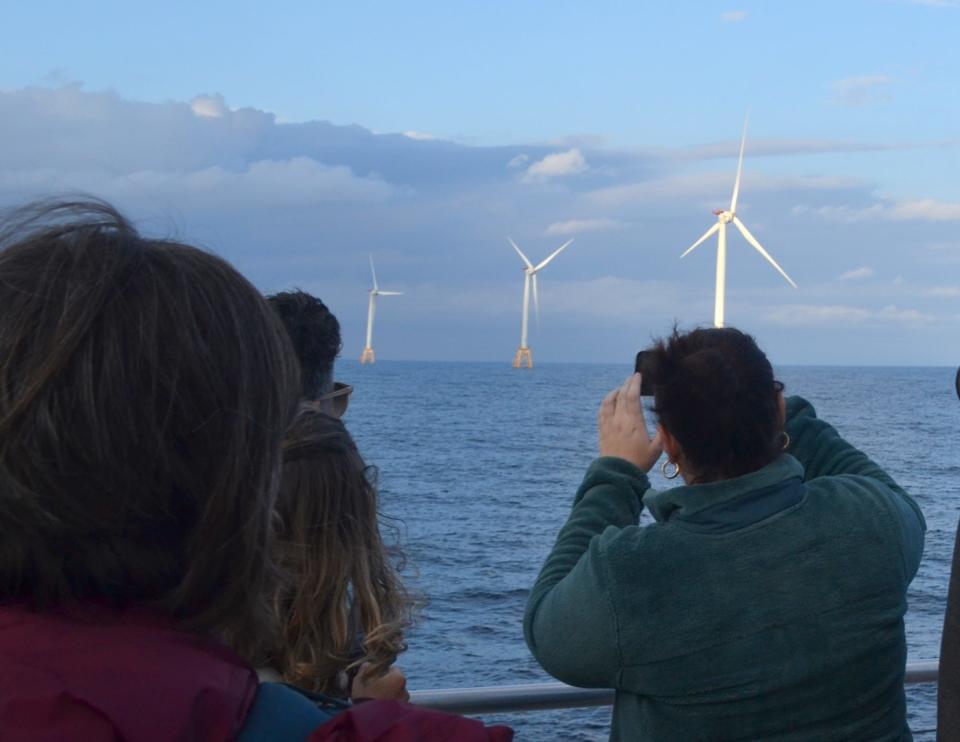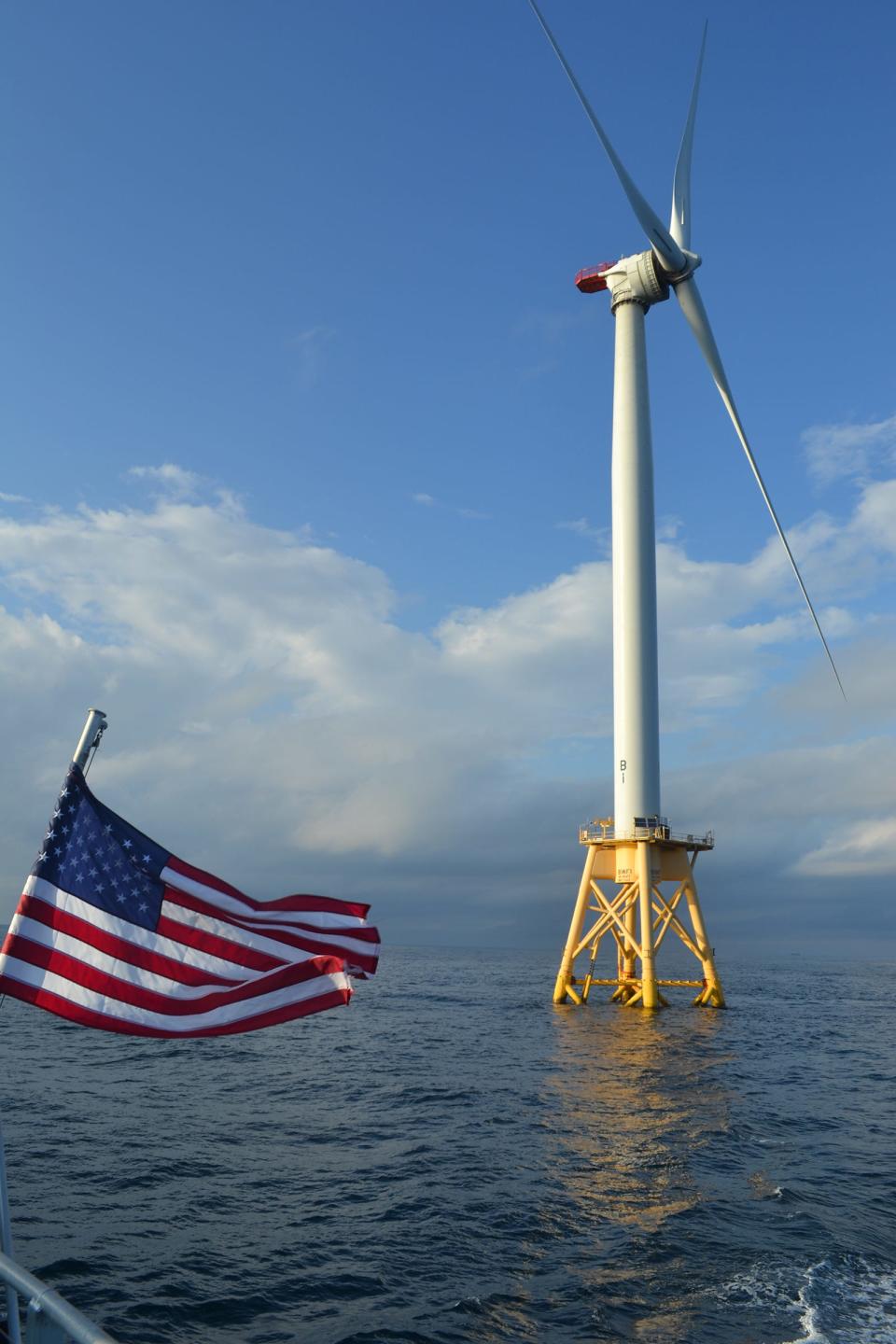Block Island wind turbines offer glimpse into energy future for Newport County and beyond
NEW SHOREHAM — The Rhode Island Fast Ferry backed out of its berth at Quonset Point and chugged south past Jamestown, a brisk wind blustering across top deck as it made its way past oyster farms, historical homes and other features of Rhode Island’s coastal environment along Narragansett Bay’s west passage.
The New England for Offshore Wind coalition chartered the ferry on Tuesday, Sept. 20 for a trip out to the Block Island Wind Farm, allowing a mix of about 100 politicians, lobbyists, consultants and renewable energy advocates from around New England to see five of the United States’ seven functioning offshore wind turbines up close.
Among all the curious visitors from Maine, Massachusetts and New Hampshire, three local legislators were also on board, checking out the turbines and soaking in information relevant to their constituents.
State Rep. Michelle McGaw, D-Portsmouth, and state Sen. Dawn Euer, D-Newport, both represent communities in Newport County, and Alana DiMario is the state senator for North Kingstown, Narragansett and Block Island — the Rhode Island communities that have been most directly impacted by offshore wind up to this point.
More: How a 100-turbine wind farm is about to change Newport County's oceanfront views
DiMario pointed out that, in addition to her constituents on Block Island who receive their power from the farm, her district also encompasses Quonset, where Orsted’s 100-turbine Revolution Wind Project intends to land its transmission line, and Galilee in Narragansett, where many of the state’s commercial fisherman dock their vessels.

She considers the Block Island farm to be a success, and pointed out the island’s residents will not feel the squeeze many Rhode Island residents will experience from significantly increased fuel costs this winter.
'People have a lot of questions'
McGaw, who represents Portsmouth, Tiverton and Little Compton, was appreciative of the opportunity to learn more about offshore wind and see a functioning wind farm in person. She said offshore wind is an increasingly common topic she hears about from her constituents, particularly in the wake of the Mayflower Wind application to run a transmission cable up the Sakonnet River and across Island Park in Portsmouth.
“People have a lot of questions,” she said. “People are cautious. I’m trying to learn and share as much information as possible.”
The country’s first offshore wind farm, comprised of five GE Haliade turbines, each producing 6 megawatts of power with a 330-foot tower topped by three 240-foot blades, is situated 3.8 miles off the coast of Block Island and is owned by Danish offshore wind titan Orsted, which acquired the project from original developer Deepwater Wind in 2018 for $510 million.
More: Residents push for benefits as Mayflower Wind continues to seek Portsmouth access
The five turbines, which were state of the art at the time of their construction but will appear puny in comparison to the newer, 16 megawatt models that will soon be installed in other offshore wind farms being built off the coast of Rhode Island and Massachusetts, provide all of Block Island’s energy, replacing diesel generators that used to burn over a million gallons of fuel annually.

The farm’s success has helped position Rhode Island as a regional and national leader in offshore wind, just as renewable energy and its attendant industries stand poised to explode over the next few years.
How does the Block Island wind farm impact sea life?
Among several speakers on board the ferry, each delivering short remarks as the boat slowly circled the turbines, Capt. Dave Monti stood out. Monti has been fishing Rhode Island’s waters for more than 50 years, runs charters out of Wickford and writes a weekly fishing report for The Providence Journal.
He acknowledged while many anglers who ply the waters of Block Island were apprehensive, or even in direct opposition to the wind farm when it was first proposed, the results of a seven-year fishing study mandated by the state and funded by the wind farm developers published in the peer-reviewed ICES Journal of Marine Science in May offered some very reassuring results.
Guest view: Sustainable future demands offshore wind, not ocean oil drilling
The study proved not only was there no significant negative effect on fish that live near the bottom of the sea — demersal fish — and invertebrate populations during the farm’s construction and operation, but the farm actually has resulted in higher concentrations of Atlantic cod and black sea bass, around the turbines.

Some of the fish caught in the study also had mussels in their stomachs, indicating they might be eating mussels growing on the turbine foundations.
Rhode Island making move toward renewable energy
Euer, who represents Jamestown and Newport, explained she actually moved to Rhode Island to pursue her law degree in part because of the maritime law specialty offered by Roger Williams University and its relevance to the legal processes required by the development of offshore wind leases.
She played a key role in Rhode Island’s draft RFP for offshore wind, a solicitation for an offshore wind procurement of 600 to 1,000 megawatts due to be issued by Gov. Dan McKee’s office on Oct. 15 at the conclusion of a 30-day public comment period.

The RFP was mandated by the Affordable Clean Energy Security Act passed by the General Assembly in July. The assembly also passed in July a law requiring 100% of Rhode Island's electricity needs be met with renewable energy by 2033.
Contextualized by Rhode Island’s participation in the Federal-State Offshore Wind Implementation Partnership recently launched by the Biden administration, which calls for the production of 30 gigawatts of offshore wind energy in the United States by 2030, it's clear Rhode Island sits at the tip of a multi-billion dollar spear that is about to revolutionize coastal economies and state power grids.
Off the coast of Block Island, those who look closely can catch a glimpse of the future.
This article originally appeared on Newport Daily News: Block Island wind farm offers glimpse into New England's energy future

